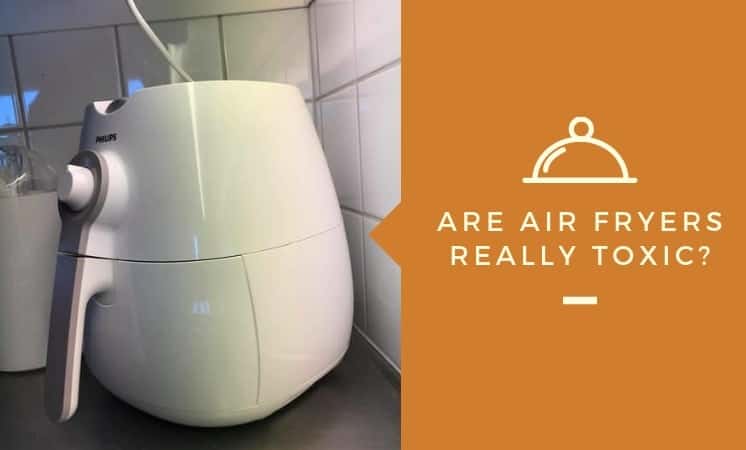With new trends come new debates, speculations and concerns along with excitement and hype. The arrival of the oil-less fryer is no exception. Considering the fact that the appliance will be responsible for cooking the food we put in our bodies, I think all questions regarding the air fryer are justified.
To better understand how cooking in an air fryer impacts our food, I decided to do extensive research on the topic.
Well, are air fryers toxic? They are not. Cooking in an air fryer reduces the formation of acrylamide (a harmful compound linked to cancer) while retaining a good amount of the nutrients in food. Additionally, the air fryer doesn’t need oil to produce a crispy exterior, lowering the fat content of food by up to 80%. With that said – make sure to use an oil suited for high-temperature cooking in the air fryer.
In comparison to many other methods of cooking, the air fryer provides much healthier alternatives. The formation of potentially harmful compounds often takes place when foods are cooked at high temperatures for a long period of time – which doesn’t happen in the air fryer.
Air fryers, with their small chambers, are very quick to reach cooking temperatures. The circulating streams of super hot air can prepare a meal in 15 minutes – a cooking period too short to start the production of acrylamide, but also too short to start depleting the nutrients foods.
In that sense, the air fryer is far from toxic. In fact, it’s actually a quite healthy alternative. Other methods, such as deep frying and boiling, can’t retain nutrients as effectively as the air fryer can.
“But wait, there’s more”.
Air fryers are praised for their ability to imitate the crispy texture produced in the deep fryer in a much healthier way. With little to no oil, the air fryer can crisp a bunch of different foods, giving them a distinct flavor and texture unique to the air fryer yet similar to the deep fryer.
Compared to cooking in a deep fryer, where the food has to be bathed in oil to produce a crispy exterior, resulting in a significant increase in calories and potentially harmful compounds such as trans-fats and acrylamide.
Acrylamide, Air Fryers, Frying, and Toxins: Is It Safe to Eat Fried Food?
It is commonly known that deep-fried food has a negative impact on our health. Many may think that the red flags connected to deep-fried foods are primarily there because of how calorie-dense the food it produces is. While deep-fried food may put many of us in a caloric surplus which may lead to weight gain, the biggest concern about eating fried food is the formation of probable carcinogens.
The aforementioned compound, Acrylamide, is a neurotoxin produced as a byproduct of a chemical reaction. The toxin can form in a bunch of different foods cooked at temperatures as high as 250F but it is most likely to form in foods that are rich in carbohydrates.
Foods which are more vulnerable to the formation of acrylamide may include the following.
- Potatoes
- Grains
- Coffee
- Cocoa Products
The compound has been linked to the development of cancer in animals. In rodents, the compound increased the risk for various types of cancer. The compound morphs into another compound called glycidamide – which then, in turn, has the ability to manipulate and damage DNA.
Subsequently, dietary studies have shown no such correlation when performed on humans. With this information in hand, one can only assume that it is smart to balance one’s intake of fried foods and to prepare food in environments that are less likely to host acrylamide.
It can be said that using an air fryer on a regular basis, with little-to-no oil in combination with other methods of cooking and a varied diet isn’t toxic. Instead, consider the fact that the air fryer has replaced the deep fryer in many households – switching from a much more toxic option to a healthier one.
Air Fryers Aren’t Toxic but Using the Wrong Type of Oil May Be

The promise of the air fryer is to produce crispy french fries, chicken nuggets, tenders, wings, and more – at the cost of no additional calories. Most air fryers and dishes do well without any oil but a single tablespoon can help the air fryer achieve even better results.
When using oils in the air fryer, one has to take two things into consideration. First, the smoke point of the oil, secondly, if the oil is a healthy alternative to use when cooking?
The smoke point of an oil indicates at which temperature an oil starts to smoke. Because the air fryer reaches quite high temperatures (400F), many oils won’t be able to withstand the heat, causing them to pass their smoke point.
The results? You’ll be standing in a smoke-filled kitchen and the flavor of your food will be affected. It is recommended to pick an oil with a smoke point above 400F to prevent your air fryer from smoking.
I suggest using these two when cooking at high temperatures.
- Avocado Oil
- Ghee (Clarified butter from India)
When cooking at temperatures below 350F I recommend using:
- Coconut Oil
Why do we pick these oils?
From a health perspective, we want to stay away from oils that are processed and contain trans fats. Consuming trans fats on a regular basis may have a negative impact on our health. A few noteworthy consequences of regularly consuming trans fats include an increased risk for:
- Type-2 diabetes
- Heart disease
- Stroke
However, an oil that doesn’t contain trans fats may still be a toxic choice for the air fryer as there are other potential risks when combining oil and heat. Oils such as canola oil and soybean oil are both free from trans fats but can still, when heated to high temperatures, form toxic substances.
To keep the toxicity of the air fryer to a minimum, use an oil that doesn’t oxidize easily to prevent the formation of free radicals.
This may seem like a lot of information but it would be clever to keep this in the back of your head if you plan on using the air fryer regularly. Considering that the purchase of an air fryer is, in many cases, justified by the health benefits and convenience it provides, using the right oil is a way to get the most out of those benefits.
How Do Air Fryers Reduce Fat & Calories?
Thanks to their method of cooking, air fryers can produce deliciously crispy results while successfully sparing our bodies from toxic compounds and calories. Using an air fryer makes it possible to enjoy the wonders of fried foods without having to worry about such things.
But how does the air fryer do that?
To understand the air fryer we need to look at how it works. Here’s a quick explanation of the air fryer’s mechanics and principles.
- The air fryer consists of a heating element and a mechanical fan.
- The heating element is located on the inside of the air fryer’s chamber and its primary objective is to heat the air surrounding the element.
- The fan is located behind the element and its purpose is to circulate the air around the air fryer’s chamber.
Thanks to the convection mechanism (warm air rises, cooler air falls to the bottom) in combination with the mechanical fan, air fryers can effectively circulate air through the air fryer’s chamber – cooking anything placed inside. Because air fryers cook by circulating hot air, one can assume that the air fryer can be categorized as dry-cooking.
The dry heat in the air fryer causes the food to dry up a little – producing a crispy surface similar to that of deep-fried food but leaner. The texture, appearance, and flavor of air-fried food is the result of a chemical reaction called “The Maillard Effect”.
The Maillard Effect is a chemical reaction that takes place when a certain amino acid comes in contact with reducing sugar in combination with heat. The reaction generally occurs when temperatures as high as 285F are reached.
You have seen it, tasted it and smelled it before – maybe without knowing it. When anything you cook in the air fryer undergoes the Maillard reaction, it creates a brown surface, commonly seen in baked and roasted food.
However, while the reaction does impact the color of food, it does much more for flavor and aromas – making them more potent and giving them more character. That way, an air fryer can produce similar results to the deep fryer without the calories and harmful compounds.
The air fryer isn’t toxic. In fact, most methods of cooking are OK as long as we use them in moderation – which can be said for many things in life. Using the air fryer as your only method of cooking may not be as healthy as one would think. While the air fryer provides a much healthier platform than deep fryers, it still fries food and fried food should be consumed in moderation.
Air Fryer Health Advantages

- Reduced acrylamide levels: Many believe that air fryers form acrylamide, which they actually don’t do, instead, cooking food in an air fryer may reduce the formation of acrylamide compared to other methods.
- Retains nutrients effectively: In comparison to many other methods of cooking, the air fryer retains a big portion of nutrients.
- May aid in weight loss: Less fat equals fewer calories, which may put the user in a caloric deficit – leading to weight loss.
- Cuts fat content: Which in turn reduces the user’s intake of trans fats.
- Rarely overcooks food: Eating food that’s overcooked and dark brown may increase the risk of developing cancer. Most if not all air fryers have timers and adjustable temperatures. When the set time is reached, the air fryer shuts off, preventing it from overcooking.
Other less health-related benefits of using an air fryer include
An Air Fryer with a Damaged Non-Stick Basket or Tray Can Be Toxic
In perfect condition, the non-stick surface is harmless – even at high temperatures. The risks come when the non-stick coat starts to peel, flake or is damaged in any way. Without the coat, the metals underneath are exposed to the heat directly when cooking – which we don’t want.
Instead of being hidden behind layers of different coats, the metals are now exposed and able to reach high temperatures. When over-heated, some metals release toxic fumes, the same goes for Teflon cookware.
When Teflon is overheated it releases a toxin that can cause semi-serious health effects to humans if inhaled. The toxin causes humans to fall into something called the polymer fume fever, a state similar to the flue. The condition is quite mild and has very few risks associated with it, for humans.
This is not the case for birds. The fumes released by Teflon are lethal to birds. Anyone who owns both birds and an air fryer should, therefore, make sure that the components aren’t Teflon, alternatively, keep the birds in another section of their home while cooking. Alas, in order for Teflon to become overheated, one would have to cook at temperatures as high as 570F, which rarely happens – fumes can still be released though.
Are There Air Fryer Baskets Without Teflon? Are They Less Toxic?
I might be a bit over-dramatic calling out Teflon the way I’ve done, but then again, exposing a bird to the fumes released by Teflon could kill it. There are signals – I’m just saying.
Thankfully, for us, there are alternatives suitable for those who want to stay away from Teflon or non-stick coated cookware. We’re looking for air fryers that are free from, preferably, BPA, PTFE, and PTOA.
- BPA: Bisphenol A, a chemical commonly used by industries who make plastics and resins. The chemical can interfere with the natural production of hormones in our body by imitating the hormones.
- PTFE: Polytetrafluoroethylene, a substance with more than one purpose but commonly known for its use in the PTFE-based formulas used to create Teflon cookware. Studies have shown that PTFE is not toxic, however, exposure or consumption of the substance over a long period of time may be harmful, we don’t know yet. But keep in mind that Polytetrafluoroethylene is the not-so-bird-friendly chemical I mentioned earlier.
- PTOA: Perfluorooctanoic acid or C8, is a chemical used when making Teflon cookware, the chemical should burn off during the process of making the product, and should not be part of the finalized product. The label PTOA-free means that the PTFE in the product was made without using PTOA.
Alright. With a greater understanding of what we’re looking for, we can start narrowing down our options. Two materials come to mind.
- Ceramically coated baskets or trays
- Stainless steel baskets or trays
In this area I have one product that qualifies, and I recommend it.

- Louise Stuhrling: This air fryer from Louise Stuhrling is entirely free from BPA, PTFE, and PFOA. Instead, the components are ceramically coated – still, even without non-stick surfaces, they are very easy to clean. The components don’t flake when used in high temperatures – make sure to clean them properly to keep them in the best condition though.
- It performs very well, comes at an affordable price tag, and has an 18-month extended warranty.
- Other noteworthy things about the Sturhling is the top-notch customer service provided by the support over at LS.
Other Less Health-Related Benefits of Using an Air Fryer
- Saving Time & Energy: The small design of the air fryer allows the air circulating the chamber to reach the desired temperatures very quickly. This cuts cooking times by quite a lot when compared to many other methods of cooking. Furthermore, while actually cooking, the air fryer doesn’t require your full attention at all times – just make sure to shake or stir the content of the basket halfway through to ensure it cooks evenly.
- Make vegetables more attractive: Turn any vegetable into a crispy snack delicious enough to attract those who didn’t fancy greens initially. This is the perfect way to get kids to eat vegetables. In fact, adding a pinch of salt and/or BBQ-spice turns vegetables into my kids favorite snack.
- Takes up very little space: There are different sizes, but generally, they are small enough to fit in most kitchen areas. When purchasing an XL-air fryer, make sure to measure its size to ensure that you have enough counter space. They can be quite big.
Conclusion: Are Air Fryers Safe or Are They Toxic?
No, air fryers are not toxic. The air fryer provides the user with a versatile toolset which can be used to make a ton of healthy alternatives which may aid in weight loss and achieving a healthier lifestyle – without giving up on the wonderful flavor of fried food.
Cooking in an air fryer is not dangerous, the misconception that an air fryer could do harm is based on the assumption that acrylamide formation is increased in the air fryer, which it isn’t. In fact, food cooked in an air fryer showed reduced levels of acrylamide.
When purchasing an air fryer it may be smart to research the product to make sure it doesn’t contain toxic materials.
Related Articles & Questions
- How to Clean Every Part of An Air Fryer
- Do Air Fryers Use Radiation to Cook?
- Are Air Fryers Good For Low-Carb Diets?
Do air fryers need oil? No, air fryers don’t NEED oil, however, using just a tablespoon of oil produces a crispier surface than no oil would.
Do you need to preheat an air fryer? The air fryer does not need to be preheated – but sometimes it is recommended to preheat. If you don’t preheat, you may have to add an extra 1-2 minutes on the clock when cooking frozen food.
Can you stack chicken in an air fryer? I wouldn’t do it. When cooking chicken we want to make sure that it is evenly cooked from all angles to prevent the Salmonella bacterium, therefore, it is important that every angle of every piece is exposed to the circulating hot air.

